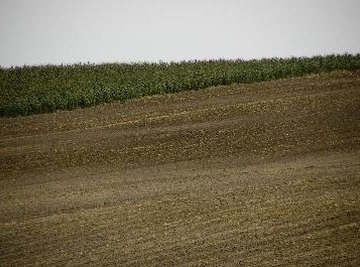
Soil is a mixture of organic and inorganic constituents. The inorganic components come from the weathering of various rock types. Organic particles are the result of both plants and animals inhabiting the area. While some soil has only one particle type, the most fertile soil is a mixture of several organic and inorganic components.
Inorganic Sand
Sand is a medium to coarse-grained sediment that is visible to the naked eye. Sand particles range in size from 0.05 millimeters to 2.0 millimeters and consist of pieces of weathered rock, such as quartz, magnetite or other mineral or shell fragments. Sand in your garden soil will help promote good drainage and aeration of the area. However, sand alone will not retain significant amounts of moisture to support plant growth. In addition, sand does not contain nutrients that promote healthy plants.
Inorganic Silt
Silt is a fine-grained sediment that you cannot see with the naked eye. Silt is larger than clay and smaller than sand and may feel gritty between your fingers. Silt particles range from 0.002 millimeters to 0.05 millimeters. Like sand, silt results from the weathering of rocks and consists of grains of quartz, feldspar and other minerals. Silt-rich soil will retain moisture for plant growth, but at times, it can limit drainage and make the soil difficult to till. Silt itself does not contain plant nutrients; however, existing nutrients in the area may adhere to the surface of the silt particles in the garden soil.
Inorganic Clay
Clay is another fine-grained sediment that is smaller than silt. Clay particles are smaller than 0.002 millimeters and result from significant weathering of rocks. Minerals, such as feldspars, degrade over time to form clay. Like silt, clay-rich soil will retain moisture for plant growth and may limit drainage in the area. You can amend fine-grained soils with sand and organic matter to improve the drainage quality of the area. Unlike sand and silt, the aluminum-silicate minerals that degrade to clay will provide important plant nutrients such as iron, calcium, magnesium and potassium. Existing nutrients will cling to the clay soil particles and help to feed plant growth in the root area.
Organic Matter
Organics in soil are due to the presence and decomposition of plant and animal matter in the area. Humus, a partially decomposed organic matter, is a common form of organics in garden soil that will continue to decompose over time. While the percent of organic matter in most topsoil is only 2 to 4 percent, it plays an important role in the garden. Organic matter is good for promoting aeration, drainage and soil moisture retention in the soil. The organic matter also reduces erosion and supplies plant nutrients such as sulfur, phosphorous and nitrogen to the plant’s root zone. The organics will also help to reduce the threat of plant disease in the garden by promoting a healthy growing environment.
About the Author
Tracy Barnhart is an earth science expert. A professional geologist with over 16 years of technical writing experience, she has expanded her writing skills to include instructional articles on business, parenting, finance and science. She has Bachelor of Science and Master of Science degrees in geology from Furman University and the University of South Carolina.
Photo Credits
soil image by michal812 from Fotolia.com
